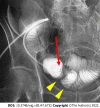Obstructive and secretory complications of diverting ileostomy
- PMID: 36620340
- PMCID: PMC9813931
- DOI: 10.3748/wjg.v28.i47.6732
Obstructive and secretory complications of diverting ileostomy
Abstract
This review aimed to highlight the etiology, diagnosis, treatment, and prevention of obstructive and secretory complications associated with diverting ileostomy (DI). Obstructive complications at the stoma site are termed stoma outlet obstruction (SOO) or stoma-related obstruction (SRO). The incidence of SOO/SRO is 5.4%-27.3%, and the risk factors are multifactorial; however, the configuration of the stoma limb and the thickness of the rectus abdominis muscle (RAM) may be of particular concern. Trans-stomal tube decompression is initially attempted with a success rate of 33%-86%. A thick RAM may carry the risk of recurrence. Surgical refinement, including a wider incision of the anterior sheath and adequate stoma limb length, avoids tension and immobility and may decrease SOO/SRO. Secretory complications of DI are termed high output stoma (HOS). Persistent HOS lead to water and sodium depletion, and secondary hyperaldosteronism, resulting in electrolyte imbalances, such as hypomagnesemia. The incidence of HOS is 14%-24%, with an output of 1000-2000 mL/d lasting up to three days. Treatment of HOS is commenced after excluding postoperative complications or enteritis and includes fluid intake restriction, antimotility and antisecretory drug therapies, and magnesium supplementation. Intensive monitoring and surveillance programs have been successful in decreasing readmissions for dehydration.
Keywords: Dehydration; High output stoma; High output syndrome; Small bowel obstruction; Stoma outlet obstruction; Stoma-related obstruction.
©The Author(s) 2022. Published by Baishideng Publishing Group Inc. All rights reserved.
Conflict of interest statement
Conflict-of-interest statement: All the authors report no relevant conflicts of interest for this article.
Figures
References
-
- Ahmad NZ, Abbas MH, Khan SU, Parvaiz A. A meta-analysis of the role of diverting ileostomy after rectal cancer surgery. Int J Colorectal Dis. 2021;36:445–455. - PubMed
-
- Borucki JP, Schlaeger S, Crane J, Hernon JM, Stearns AT. Risk and consequences of dehydration following colorectal cancer resection with diverting ileostomy. A systematic review and meta-analysis. Colorectal Dis. 2021;23:1721–1732. - PubMed
-
- Karjalainen EK, Renkonen-Sinisalo L, Mustonen HK, Lepistö AH. Morbidity related to diverting ileostomy after restorative proctocolectomy in patients with ulcerative colitis. Colorectal Dis. 2019;21:671–678. - PubMed
-
- Ihnát P, Guňková P, Peteja M, Vávra P, Pelikán A, Zonča P. Diverting ileostomy in laparoscopic rectal cancer surgery: high price of protection. Surg Endosc. 2016;30:4809–4816. - PubMed
Publication types
MeSH terms
Substances
LinkOut - more resources
Full Text Sources
Medical



